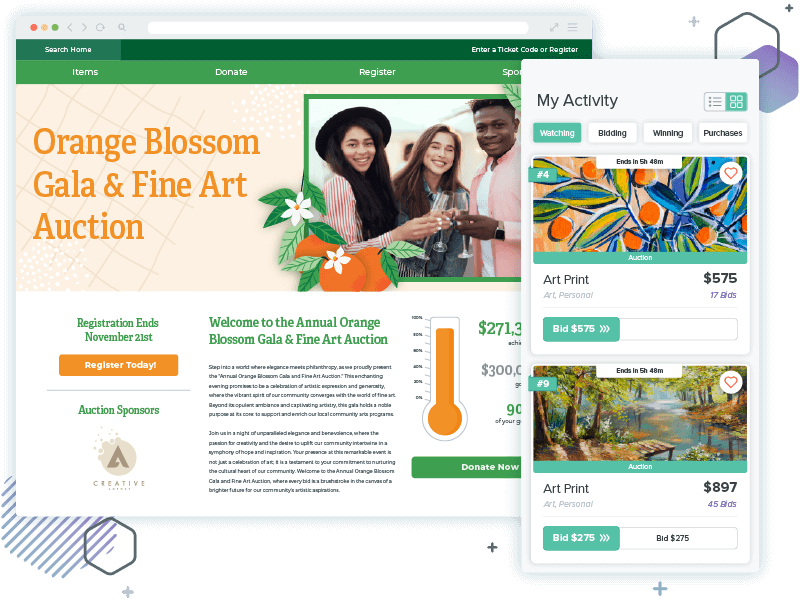Silent auctions are a great way for your organizations to boost your fundraising efforts throughout the year. Whether your silent auction is a part of a larger event or held on its own, you can captivate your donors with an engaging bidding experience that motivates them to give more to your cause. By using some auction tips and tricks, you can host a successful silent auction to raise more funds for your nonprofit.
Use this guide to learn more about hosting a silent auction!
- What is a silent auction?
- How to run a silent auction
- Silent auction items
- Software for silent auctions
What is a silent auction?
A silent auction is typically held as part of a larger fundraising event where items for auction are put on display, and bids are made without an auctioneer. At the conclusion of the bidding period, the highest listed bidder wins each item. Silent auctions can be held completely virtually, in-person, or a mix of both with a hybrid auction. While in-person silent auctions as part of an event are the most common, virtual and hybrid silent auctions can help you raise more money by providing options for your supporters that can’t join in person!
How do silent auctions work?
During a silent auction, multiple items are displayed, usually on tables, and your guests can walk around and view each item more closely. These items can be purchased by your organization or can be collected as in-kind donations from your supporters or local businesses. If they’re interested in placing a bid, they can write it down on a sheet of paper next to the item, or if you use bidding software, they can place a bid on their laptop or mobile device. While paper bidding sheets may work best for some auctions, mobile bidding can help you increase the number of bids you receive per item. Mobile bidding is super convenient, and it gives you the ability to notify your guests when they’ve been outbid. The guest with the highest bid when the auction closes then wins the item.

Why are silent auctions popular?
Silent auctions are popular for a variety of reasons, one of the biggest being their ability to help you forge new relationships and begin the donor cultivation process. When it comes to gathering support for your organization, you can find new prospects through:
- Donated items. It’s fairly easy to get local businesses to donate items for auctioning off at your event. During this process, businesses will become more familiar with your organization and help support your cause. From there, you can begin engaging them and cultivating them as regular donors.
- Community. Many guests at your silent auction may bring their friends and coworkers to the event. These are also great new prospects for your nonprofit, who you can reach out to afterward with thank-you letters, ways to get involved, and more.
Why do nonprofits turn to silent auctions?
Silent auctions are an excellent way to build up your revenue for a larger event and keep your guests entertained. As long as you take the time to procure exciting items that guests will want to bid on, the energy put into planning the event will be well worth the results.
Benefits of a silent auction
There are quite a few benefits of hosting a silent auction, including:
- Affordability. Silent auctions don’t have to be an expensive event. Using in-kind donations as auction items and taking advantage of online tools, silent auctions can be an inexpensive way to raise money.
- Comfortability. With silent auctions, your donors can place their bids quietly and spend the rest of the event time socializing or just enjoying the event.
- Flexibility. Because your donors can choose to donate items or bid on items within their budget, silent auctions provide people with multiple options to support your cause which can help you expand your donor base.
- Retainability. Engagement is one of the key ways you can increase your donor retention rate, and silent auctions provide you with multiple paths of engaging with your auction attendees. From auction announcements to the event experience to your follow up strategy, there are multiple phases throughout the silent auction process to keep your donors engaged with your mission.
How to run a silent auction
If you’re wondering how to run a silent auction, it’s important to consider some key steps. Running an event like this means planning before the event, staying on top of things during the auction, and following up with participants afterward. Take these steps to make sure yours is a success:
Before the event
- Assemble your auction team. Auctions require a bit of planning, and you’ll need to recruit staff members and volunteers to help you through the process. Your team should consist of logistics planners, item procurers, auction monitors, and other volunteers to help set up, assist guests who have questions, and clean up after the event.
- Procure items. Reach out to local businesses and individuals and explain your cause and what the items will go to benefit. Be sure to procure a variety of items, including tangible goods as well as services (lessons, experiences, etc.) that will appeal to your donor base. Auction items that directly relate to your cause (e.g. pet gift basket for an animal rescue auction) help keep your bidders’ minds on your mission.
- Advertise your event. Be sure to promote your event beforehand. After all, if people aren’t aware of the great items you procured, they won’t know to come and bid on them! Use email, social media, direct mail, and texts to announce your silent auction and excite your supporters. You can even use silent auction software to allow guests to preview the items beforehand.
- Use online registration. Silent auction software provides the ability to create and manage your event online. Utilize an online event registration form to sell tickets, process payments, and offer a preview of what’s in store for your guests. An effective and responsive registration experience can help you increase attendance.
- Establish bidding rules. To keep your silent auction running smoothly, you want a set of rules your guests will follow when bidding on items. Set starting bids based on 40% the fair market value (or $5 for smaller prizes) with a wide range of prices to appeal to many donors. You should aim to earn about 70% of an item’s fair market value in four bids or less. Ensure an item’s bid increments, closing bids, and bid cancellation rules are visible and easy for your donors to understand.
- Set up early. Try to set up a day before the event if you can, or several hours before the event if you can’t, and designate certain volunteers to go to the store if any supplies have been forgotten. Display big-ticket items strategically within your venue and organize your items by their price point for an easy bidding experience. You should make your displays aesthetically appealing with stands and branded cards explaining what the time is.
During the event
- Implement your check-in and check-out procedures. Create a plan to have in place for checking your guests in and out. This can be done through your auction software and by having volunteers strategically stationed throughout the event. However you handle it, your check-in strategies should be as streamlined as possible to avoid frustrations and delays among your guests and your staff.
- Keep guests updated and engaged throughout the event. Your silent auction software can help streamline this, keeping bidders updated on their bids and engaged in the activities. They should also be notified when the auction is coming to a close. You should also encourage your staff to get involved with the auction and socialize with your supporters during the auction or share impact stories throughout the event.
- Raise money through additional avenues. Whether you sell merchandise or use Fund-a-Need donation appeals, you don’t have to rely on auction bids as the only means of revenue for the event. You can even sell extra drink tickets for your donors that want to use your auction as a fun night out.
After the event
- Process the payments. Because your auction software will collect bids and payment information for the auction items, you’ll be able to easily process payments for the items once bidding is closed.
- Process leftover items. For people who don’t want to pay for the items they bid on, contact the individual with the second highest bid to see if they still want the item. For items that go unclaimed, use your auction software to find the contact information of the highest bidder to notify them again that they won.
- Wrap up the event and follow up with thank-yous. Once your guests are checked out and have claimed their items, be sure to follow up and thank them for their support. You should also send personalized thank-you notes to those who donated items for the event and show appreciation for the volunteers who helped make it run smoothly. You can also add a post-event survey to your acknowledgments to get feedback from your guests.
- Analyze event success. Run a performance review on the auction to determine the success of your event. Look at how much you raised, new donors you’ve recruited, and review any feedback you get to make your next auction even better.
Running a silent auction doesn’t have to be daunting if you take the necessary steps and have a planning process in place. Stay on top of each activity by recruiting volunteers, streamlining your auction processes, and following up with your attendees after your event.
Silent auction items
It’s clear that having the right auction items will raise more revenue at your auction event. Here are a few of our favorite silent auction items that you can procure in order to bring in more bids and garner more support for your organization:
- Gift cards. Reach out to local restaurants and retailers to see if they’ll donate a gift card for your event. They can even be listed as a sponsor to help them gain some publicity.
- Spa day. Spa days are great silent auction items, as they will appeal to many bidders. See if some local spas will donate a gift certificate for a couple of treatments.
- Signed memorabilia. Signed memorabilia can drive in a lot of revenue for your silent auction. Depending on your location, see if any local sports teams are willing to donate something meaningful.
- Technology. Procure the newest gadget, whether it’s a tablet, computer, smartphone, or TV. This auction item will be sure to drive up the bids.
- Trips. Partner with local travel agencies or resorts to provide a little vacation experience. These trips can help bring in big bids because of their value.
Software for silent auctions
If you’re planning a silent auction, finding the right software is essential. With silent auction software, you can streamline your entire event from start to finish.
Be sure to incorporate these software features to make your silent auction a success:
- Online event registration. Offering event registration online simplifies the overall process and gives you an accurate headcount of attendees. Set up your online event registration page using custom fields that gather important information from your attendees.
- Guest management. Manage your ticket options and table seating with easy guest management tools. These tools help keep your event on track and your guests happy with their experience.
- Fund-a-Need. Ask for donations during your auction with Fund-a-Need appeals. These appeals can be for specific projects or scholarships, and your supporters can complete their donation when they check out in one transaction.
- Mobile bidding. Mobile bidding is an updated process that allows nonprofits to raise more at silent auctions. Through mobile bidding, your guests can look through the items in the auction and place bids from their phones. They can bid manually or even set a maximum bid amount so that the software bids on their behalf. Mobile bidding can be done through an app or online and provides your guests with notifications whenever they’ve been outbid.
- Easy check in and check out. Online event registration streamlines the check-in process, as the information has already been collected from attendees upon arrival. Because bidding software allows auction guests to pre-register their payment information, the check-out process will be less involved and easier to navigate.
- Convenient payment collection. Once the auction attendees have won their items, they can easily send payment through your auction software.
- Automated receipts and thank–yous. With online and in-app payments, your nonprofit can automate your auction receipts and follow-up acknowledgements to be processed and sent out immediately following the checkout process.
- Reporting and analytics. With dynamic reporting from your event registration and bidding software, you can track registrations, donor information, the total revenue brought in by bids, and more.
Your auction and event software can make the entire planning process easier by streamlining each step. Find the platform that works for you, and you’ll be ready to put on a great silent auction!
Final thoughts
Planning a silent auction doesn’t have to be a challenge. With the right tools and resources, you’ll be able to navigate each step and keep your guests engaged. Take this guide and start planning your next great auction event!
If you’re looking for more information about auctions or fundraising in general, check out the additional resources below:
- How to Obtain In-Kind Donations for Auctions and What Auction Items Work. Putting on a good auction requires having the right items. Explore the ways you can procure the items you need to make your event a success.
- 3 Ways to Promote Auctions on Social Media. If you want to promote your auction event, social media is a great outlet to use. Check out these strategies you can use to build hype around your upcoming event.
- Hosting Hybrid Auctions: A How-To for Nonprofits. Hybrid auctions can help you reach more donors by providing flexible attendance options. Use this guide to host a successful hybrid auction.
- 11 Online Auction Website Best Practices for a Dynamic Virtual Event. With the advancement of technology, there are more and more ways for you to engage with your donors online. Learn more about virtual auctions with these 11 best practices.






